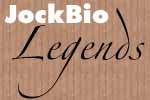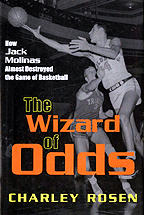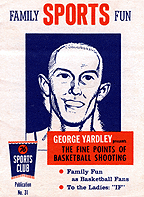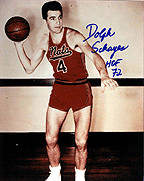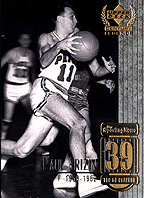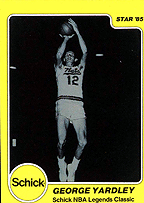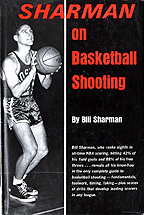|
|
|
| |
 |
|
| |
Upon
first glance, the early history of the NBA would seem to divide
neatly into two distinct eras: Laker dominance, followed by
Celtic dominance. What gets lost in this glossing over, however,
is the critical bridge between them—and the paradigm-altering
players who helped basketball evolve from a bone-rattling
brawl to the smooth game it is today. One of the key figures
in this transitional period was George “The
Bird” Yardley, an engineering genius who owned
the first great turnaround jumper in the NBA. A 20-point scorer
until his final NBA game, George walked away from basketball
in the early 1960s and into the shadows of basketball history.
For all but the most ardent NBA fans, his achievements did
not come to light again for more than three decades, when
he was finally inducted into the Hall of Fame. Historian Jim
Sargent, who rooted for George Yardley as a young fan, brings
his career into sharp focus in this JockBio Classic.
George
Harry Yardley III was born November 3, 1928, in Hollywood,
California, to George and Dorothy Yardley. George’s
father was something of a Midwest sports legend, becoming
the first person to captain the football and basketball teams
at the University of Chicago. George was an athletic child,
though he did not play organized ball until high school. Like
most children of means in Southern California, he was handy
with a tennis racket. He later took up golf.
George
enrolled at Newport Harbor High in 1942, playing football,
basketball and tennis for the school teams. As a senior in
1945-46, he made the All-Sunset League First Team as well
as earning Third Team All-CIF honors. Tall and skinny with
long, loping strides, he did not attract serious scholarship
consideration from any colleges, but was proficient enough
as a student to earn acceptance to Stanford University, where
he would earn a Bachelor’s Degree in Civil Engineering.
George
made Everett Dean’s varsity basketball squad as a sophomore
in 1947-48, and was named to the All-Conference Second Team
as a junior. His best season came as a senior in 1949-50,
when he was co-captain with Gus Chavalas. The squad also included
Jim Ramstead, a talented junior. George scored 237 of his
team-high 423 points in Pacific Coast Conference games, breaking
the PCC scoring mark of Stanford legend Hank Luisetti.
Luisetti
was famed for introducing the running one-handed shot to basketball.
George did not have the moves of his fellow Stanford alum.
Instead, he was an early master of the turnaround jumper.
He got off the floor very quickly for a man his size, and
with his long arms could shoot over most defenders at will.
Though he could not know it at the time, the turnaround was
tailor-made for the game that would evolve after the 24 second
clock was introduced to pro ball. In 1949-50, George’s
jumper was good enough for 16.9 points per game and honorable
mention as an All-American. He finished his college career
with 820 points.
It was
at Stanford that George acquired his nickname, “Bird.”
Contrary to stories that circulated later, it did not come
from his leaping ability, nor was it a reflection of his flamingo-like
frame. The tag had nothing to do with basketball. In the fall
of 1946, as a 17-year-old pledging a fraternity, George was
younger than most frosh, because many of them were World War
II veterans. Usually he got stuck with the dirty jobs. His
ex-soldier roomie said guys who did the dog work in the Army
were called “yardbirds.” Yardley was dubbed “Yardbird,”
which was shortened to “Bird.”
In the
spring of 1950, George was the first draft pick of the Ft.
Wayne Pistons. Other first-rounders that year included Paul
Arizin, Bob Cousy and Larry Foust. Hesitant to move east,
and wary of the low salaries being paid by the pros—especially
after the absorption of the National Basketball League by
the newly renamed National Basketball Association—George
worked locally and played AAU ball for the San Francisco Stewart
Chevrolet team, which was coached by Luisetti. He averaged
13.1 points in 1950-51 and led his team to the AAU national
title.
In the
semifinals of the 44th annual AAU tourney, played in Denver,
Yardley was the biggest star. Against the Phillips 66ers and
their famed seven-foot center Bob Kurland, he scored 25 points
and, showing his quickness, made several steals. The San Francisco
club won, 66-63, in three overtimes, thanks to a pair of clutch
free throws by George in the final minute. Rob Yardley, George’s
son, recalled that his father considered this victory over
Kurland’s team—the defending champion
and winner of seven of the eight previous AAU tournaments—to
be his “finest moment.”
|
|
| |
In
the AAU finals, George burned the nets for 32 points—including
20 in the first half—and the Stewart Chevrolets ran
away from the Colorado Collegians (players from Colorado A&M),
76-55. George, said the Los Angeles Times, “turned in
a spectacular all-around game and with his amazing jumps took
the ball off both backboards with phenomenal regularity.”
The Bird was named tournament MVP and was honored as an AAU
All-American for the season.
George
continued to rebuff Fred Zollner’s attempts to sign
him for the Pistons. To a man with an engineering degree and
a shot at making the Olympic team, the $6,000 being offered
by Ft. Wayne (about 50 percent more than the average NBA salary)
was not particularly tempting.
Before
the 1951-52 season, George decided to enlist in the Navy and
fulfill his military obligation while playing ball for Los
Alamitos Naval Air Station. He led the Chevrolets back to
the AAU tournament and won All-American honors again. Unfortunately,
he suffered a broken hand in the last game of the AAU season,
ending his Olympic dream. Bob Kurland, Clyde Lovellette, and
other college and AAU stars won the Olympic gold medal for
America with relative ease in 1952.
In 1952-53,
George led Los Alamitos to its first ever All Service title,
and a second-place finish in the national AAU tournament.
On March 21, 1953, playing in the finals, again at Denver,
Los Alamitos fell to the defending champion Peoria (Illinois)
Diesel Cats, 73-62.
George
led all scorers with 29 points. According to the Chicago Tribune,
when the erstwhile Stanford whiz left the game in the final
minutes, the enthusiastic crowd of 6,500 gave him a “thunderous
ovation.” After the game, when he came forward to receive
his trophy as an AAU All-Star, chairman Lou Wilke called George
“the greatest basketball player in the world today,”
prompting another huge ovation from the appreciative audience.
That
summer, George joined a tour of South America with a team
of amateur All-Stars. He later told the Los Angeles Times
they played before 20,000 fans in Buenos Aires, and Juan Peron,
Argentina’s dictator, invited the Americans to his villa
for a weekend. At this point, George had decided to turn pro.
Having received national recognition as an outstanding player,
he waited until a salary was offered commensurate with his
reputation. He stayed in shape playing beach volleyball, and
he married his longtime sweetheart, Diana Gibson. On Saturday,
August 29, 1953, the couple exchanged vows in Westwood, California.
They had been introduced by their grandmothers.
Two days
later, the Pistons announced that they had signed George.
The figures, not made public, included a $9,500 salary—more
than double the NBA’s average at that time—and
a $1,500 bonus. By the end of his career he would nearly triple
that salary, earning as much as $28,000 in 1958—a very
good pro sports salary for the decade.
|
|
| |
George
was part of an exciting influx of amateur talent in 1953-54.
Also joining the NBA that season were AAU superstars Clyde
Lovellette, Ernie Barrett, Walt Davis and Don Sunderlage.
George joined a good Pistons team coached by Paul Birch. Veteran
guards Andy Phillip and Fred Scolari handled backcourt duties,
with Max Zaslofsky joining the team during the year and taking
over from Scolari as the starter. The Pistons’ front
line included center Larry Foust and forwards Don “Monk”
Meineke (the reigning Rookie of the Year), Mel Hutchins (the
NBA’s best defensive forward), and rookie Jack Molinas,
an exciting star drafted in the first round out of Columbia
University.
George
failed to become a regular at first. Molinas, a terrific finesse
player and a talented offensive rebounder, made the starting
lineup ahead of George, despite a complete disinterest in
playing defense. This irked his Ft. Wayne teammates, who felt
he was not earning his points at the other end of the court.
But coach Birch, who was instrumental in drafting Molinas,
gave his man carte blanche.
|
Andy
Phillip, Bowmsn Card |
| |
George’s
playing time finally increased in the second half of the year,
after Molinas, accused of wagering on Pistons game, was suspended
on January 10, 1954, by commissioner Maurice Podoloff. George
played in 63 of the team’s 72 regular season games,
averaging 9.0 points and 6.5 rebounds. The Pistons finished
third in the NBA’s four-team Western Division with a
record of 40-32. The NBA, whittled down to nine teams at this
point, adopted a confusing round-robin playoff format involving
three teams from each division. The Pistons lost two games
to the Rochester Royals and two to the Minneapolis Lakers,
who went on to defeat the New York Knicks in the finals for
the NBA title. George was entrenched at forward by this time,
and he tied for the team lead with 42 postseason points.
Although George made his mark on the league as a rookie, he
must have had second thoughts about playing in the NBA. The
1953-54 season marked a low point for the league in terms
of the quality of play. Anyone coming within 10 feet of the
basket could count on being hammered, thus neutralizing driving
guards and forwards and turning the foul lane into a back-alley
brawl. Referees let the players go at it, knowing if they
whistled every foul, the fans would boo the endless free throw
shooting that would result. These were the days of the one-shot
foul, so anyone with a decent chance of scoring a basket was
usually hacked before getting a good look. With no shot clock,
the end of games either came down to foul-shooting contests
or out-and-out stalls.
This scenario
spelled potential disaster for the NBA, which had just signed
its first-ever TV deal with NBC. Basketball fans that gravitated
from college to the pros after the NCAA scandals of 1950-51
hated the action they were seeing on the court. And when the
Molinas story broke, the NBA could no longer claim it was
“clean.”
George
was appalled by the violence he encountered in his first season.
“The first time around the league as a rookie, they
just didn't push you around—they hit you with a clenched
fist in the face,” he later told the Los Angeles Times,
adding that he received 100 stitches to his face during his
career.
“The
weak didn't make it,” he said.
The NBA
had to do something. During the following year, the 1954-55
season, the 24-second shot clock was introduced, and it revolutionized
the league. From a game dominated for decades by the buffalo,
pro ball now belonged to the gazelle. And although there would
always be a place in the NBA for the bruising, physical defender
and rebounder, a team could no longer afford to put too many
thugs on the court. Time was, quite literally, running out
on this approach.
For players
like George, the shot clock changed everything. It enhanced
the value of players who could create their own shot and the
value of players who could get open looks for their teammates.
George fell into the former category. He was comfortable shooting
the ball squared-up, on the move, leaning one way or the other,
and, of course, starting with his back to the defender and
spinning as he rose off the hardwood. In 1954, he was one
of the few shooters in the league who were willing and able
to fire up high-percentage shots within 24 ticks. And this
would make George a star of an entirely new magnitude.
About
his shooting ability, George later recalled, “I was
one of the best jumpers in the league, and I could move my
body to one side or the other when I was shooting and still
control my shot, which helped me shoot over other players.”
|
|
| |
As
was the case with many early players, George utilized the
backboard a lot. “I think you can shoot the ball harder
and with more accuracy by using the backboard,” he said,
“because your distance doesn’t have to be exact,
since you can put it off the board and it will bounce into
the basket. I didn’t bank it on straight-on shots or
from the baseline, but I usually hit the board on shots anywhere
between the baseline and out front.”
Frank
Ramsey, Boston’s great sixth man who came to the NBA
a year after George and ended up shooting his way into the
Hall of Fame, described for Terry Pluto in Tall Tales the
Yardley technique: “George had a turnaround jumper—he
took it right in your face. He just jumped over you and shot
like the guys do today.”
George
was not only the right man at the right time, but he was also
in the right place. Fred Zollner hired a new coach, former
NBA referee Charley Eckman. Despite his inexperience, he knew
enough about pro basketball to recognize that, with the new
24-second rule in place, the Pistons would be better off if
he kept the team loose with jokes and simply let the veterans
freelance. Indeed, years later Eckman would boast that his
team did not call any set plays; but one season earlier, this
would have been unthinkable. For George, it meant freedom
on the offensive end. It also meant, more than ever, he would
be a target for fists and elbows. It was a trade-off he was
apparently willing to accept.
At first,
Eckman did not know what to make of George. “He was
such a skinny, chalky-white bastard that you thought he was
dying from malnutrition,” he said for Terry Pluto’s
Tall Tales. Also, George, who was easy going off the court
and apparently relaxed on the court, was actually a very intense
competitor. Often he got sick just before a game, so Eckman
kept a case of Ginger Ale or 7-Up on hand for George, just
in case. The coach once observed, “When he goes so far
as to toss his cookies, well, then we know he’s going
to play a hell of a game. It’s when he doesn’t
get sick that we worry.”
But soon
George’s value to the team became apparent. He led the
Pistons with 17.3 points per game, and combined with Foust
and Hutchins to haul down nearly 30 rebounds a night. At guard,
Phillip proved to be a superb set-up man. The Pistons were
talented and deep. They blended an undisciplined-yet-effective
offense with the NBA’s best defense and went 43-29 to
finish three games in front of the defending champion Minneapolis
Lakers in the West. The Lakers were without George Mikan,
who retired after the 24-second shot was instituted. He had
no taste for sprinting up and down the court three or more
times every minute and correctly anticipated the game was
passing him by.
After
a first-round bye, the Pistons defeated the Mikan-less Lakers
in the playoffs, playing their two home games away from Ft.
Wayne, in Elkhart and Indianapolis, because their gym was
unavailable for postseason games. The lack of a homecourt
advantage nearly cost them in Game Two, as they needed an
extra period to down Minneapolis 98-97. The Lakers took Game
Three with an overtime victory of their own, but the Pistons
came back to finish off the best-of-five series with a 105-96
victory.
This earned
Ft. Wayne a berth in the NBA Finals against the Syracuse Nationals.
It may not have been a coincidence that Danny Biasone, the
man who sold the league on the shot clock, was part owner
of the Nats. Like the Pistons, Syracuse was made for the new
game. Coach Al Cervi’s squad had skilled players at
several key positions, including Dolph Schayes at forward,
Paul Seymour and George King in the backcourt, and young Johnny
Kerr off the bench. Earl Lloyd and Red Rocha functioned as
enforcers.
The finals
opened in Syracuse with George and the Pistons looking to
grab the momentum. They had Game One under control until benchwarmer
Dick Farley entered the game for the Nats in the fourth quarter.
He sparked his club to an 86-82 comeback victory. The Nationals
got a big game from Schayes and a clutch shot by Rocha to
take Game Two, 87-84.
|
George Yardley Booklet |
| |
The
Pistons limped back to their new home away from home (Indianapolis)
and proceeded to turn the tables on the Nationals. Hutchins
starred in a 96-89 Game Three victory, and the Pistons knotted
the series with a 109-102 shootout in Game Four. Game Five
saw Fort Wayne establish a 15-point lead in a tense defensive
struggle, only to have the Nats storm back and threaten to
steal the game. Their momentum was final broken by an irate
Pistons fan, who threw his folding chair onto the court and
had to be escorted from the arena. The Pistons held on for
a 74-71 win and a 3–2 series lead, but the last two
games would be played in Syracuse.
Back
home in their cramped arena, the Nationals were brimming with
confidence. The Pistons had not won in their building in six
seasons, and there was no reason to expect that this trend
would change. In Game Six, there was a glimmer of hope for
Ft. Wayne, but that ended when a fight between Don Meineke
and Wally Osterkon woke up the crowd and the team, and the
Nats evened the series with a 109-104 win.
George
had played well throughout the postseason, and was seen by
many as a key to the Pistons Game Seven hopes. The Nats obviously
agreed, as they gave him special defensive attention and limited
him to just nine points. However, the focus on George opened
up opportunities for other Fort Wayne players, and the Pistons
found themselves with a 17-point advantage early in the second
half. Cervi inserted Farley and another super-sub, Billy Kenville,
and their energy quickly turned the game around. The Nats
took a 91-90 lead on a pair of Schayes free throws, then fouled
George, who sank his shot to tie the game at 91-91 with less
than a minute left. Syracuse went ahead after guard George
King converted one of two free throws with 12 seconds left.
When King and Paul Seymour batted the inbounds pass away from
Andy Phillip, the buzzer sounded and the Pistons lost, 92-91.
Fort
Wayne paced the West again in 1955-56, but with a mark of
just 37-35. George topped all Piston scorers at 17.4 points,
with Foust a close second at 16.2. The team’s backcourt
was revamped with the release of Zaslofsky and diminished
playing time for Brian. Rookie Chuck Noble was inserted in
the starting lineup and Corky Devlin spelled Phillip, who
was now 33 years old. Neither Noble nor Devlin was drafted,
making Eckman’s team as walk-ons.
After
a first-round bye in the playoffs, the Pistons met the St.
Louis Hawks, who had dispatched the Lakers in the first round.
Mikan had returned for Minneapolis, but was no longer an impact
player. The Hawks, on the other hand, had a couple of talented
scorers in Bob Petit and Jack Coleman, and a couple of razor-sharp
bench players in Jack McMahon and Alex Hannum—both of
whom would go on to coach NBA champions. St. Louis gave the
Pistons all they could handle in the best-of-five series,
taking the first two games before dropping the final three.
Waiting
for the Pistons in the finals were the Philadelphia Warriors.
They were going to be trouble. The team had the two biggest
guards in the league—Tom Gola and Jack George—along
with forward Paul Arizin and center Neil Johnston. Gola, a
center in college, was a player built for the new NBA, as
was Arizin. Like George, they were capable of scoring whenever
they touched the ball. Johnston, an old-style hookshot artist,
gave the Warriors an added dimension in the pivot.
In the
opener, the Pistons dug in on defense and built a double-digit
lead. Philadelphia coach George Senesky had obviously studied
Fort Wayne’s last trip to the finals, because he inserted
a high-energy substitute named Ernie Beck. Beck started hitting
shots and getting the home crowd into the game, and the Warriors
were in control the rest of the way to a 98-94 win.
Game
Two, in Fort Wayne, went to the Pistons. George was the man,
calmly hitting two clutch free throws with 42 seconds left.
The Warriors put the ball in Beck’s hands again, but
this time the magic was not there. Devlin stole the ball and
drove for what should have been the deciding layup, but missed
the shot. The Warriors called time and set up one final play.
They inbounded the ball, and Arizin drove under the bucket.
According to the Fort Wayne Journal-Gazette, “Yardley
blocked his shot and gained possession of the ball. The Pistons
held it up for the few seconds needed for the final buzzer.”
George’s game-high 30 points, 19 rebounds, late free
throws, and defensive gem had preserved an 84-83 victory.
|
Dolph Schayes Autographed Photo |
| |
The
teams returned to Philadelphia for Game Three, and once again
it was close, with the Warriors winning 100-96 on 27 points
from Arizin. Piston fans greeted their team for Game Four,
expecting them to even the series. Philadelphia had never
enjoyed much success in their building, but Arizin proved
unstoppable again, leading his club to a 107-105 victory with
30 points. A late rally by the Pistons fell just short. The
Warriors wrapped things up 98-88 in the City of Brotherly
Love, ending a brief but closely contested final. George led
the team in scoring for the series, and he was Fort Wayne’s
overall postseason leader, averaging 23.0 in 10 playoff games.
In 1956-57,
the Pistons tied for first in the West, although the three
top teams, Fort Wayne, St. Louis, and Minneapolis, all finished
with losing marks of 34-38. For the season, George again topped
the club in scoring, averaging 21.5 points on 41 percent shooting.
He finished fifth in the league scoring race. He also averaged
10.5 rebounds, which ranked ninth in the NBA. The Pistons
still had a great front line, with Foust, Hutchins and Bobby
Houbregs joining George, but the guard situation remained
in flux. Andy Phillip was dealt to the Celtics, and Gene Shue
was brought in from the Knicks to run the offense. Noble and
Devlin were still in the mix, along with Billy Kenville, but
the team failed to get reliable production from its guards
all year long.
With
first place in the West undetermined at season’s end,
two tiebreaker games were played. The Hawks beat Fort Wayne
115-103 in the first and Minneapolis in the second tiebreaker,
114-111, to claim the division championship. That left the
Pistons and Lakers to go at it in the opening round of the
playoffs. The Pistons bowed out after losing a pair of barnburners
to the Lakers by scores of 131-127 and 110-108. The finale
came on March 19, 1957, at Memorial Coliseum. Dick Schnittker
of Minneapolis missed a free throw with four seconds to play,
but teammate Clyde Lovellette grabbed the rebound away from
Larry Foust and dunked it, giving Minneapolis a 109-108 lead.
The Pistons called two timeouts trying to set up a final shot,
but the second timeout was one too many. Shooting the technical,
Schnittker scored a free throw for the game’s final
margin.
|
Paul Arizin, Upper Deck Century Legends Card |
| |
For
the 1957-58 season, Fred Zollner moved the Pistons franchise
to Detroit, where the club shared Olympia Stadium with the
Red Wings. In the final standings, the Pistons slipped a game
to a 33-39 record, tying the transplanted Cincinnati Royals,
who moved from Rochester in 1957, for second place. The Hawks
led the West at 41-31, thanks to fine seasons by Bob Pettit
and Cliff Hagan. They would go on to win the championship
that spring.
Charlie
Eckman did not make it through the year. He was replaced by
Red Rocha after winning just nine of the first 25 games. Under
Rocha, the Pistons improved their record to 34-38.
T he Pistons
were a profoundly different club in a number of ways. Gone
were Foust, Hutchins and Devlin—dealt away for point
guard Dick McGuire, rebounding specialist Harry Gallatin,
and two of the league’s early African-American stars,
Sweetwater Clifton and Walter Dukes.
In a lineup
that often featured a trio of 30-something ex-Knicks, George,
now 29, became Detroit’s go-to guy. His high game was
a 52-point performance against Syracuse on February 4. He
hit for 48 against the Nats two weeks later. George also netted
51 against Boston on January 15, despite being guarded for
much of the game by Bill Russell. He also blitzed St. Louis
for 48 and 44 points and burned Minneapolis for 49, 44, 43,
and 41-point nights.
By early
March, George was within striking range of the NBA scoring
mark. On March 6th, the Bird set a new NBA single-season record
during his 49-point night against the Lakers in Minneapolis.
He eclipsed the old mark of 1,932 on the home floor of its
former owner, George Mikan, who achieved this figure in 1950-51.
George also set a new season mark for free throws in this
contest, sinking 11 for a total of 635. He finished the year
with 655. Dolph Schayes held the old record of 625 in a season.
At the
Boston Garden on March 8, the Celtics, in a nationally televised
game, defeated the Pistons, 108-103. With the East title already
clinched, Boston’s primary focus was on defending George.
It worked as the Pistons’ ace could score 22. But the
next day, in Detroit’s regular season finale at Syracuse,
George broke the once seemingly impossible 2,000-point barrier.
He started with 13 in the first quarter, but the Nationals’
Earl Lloyd held him to one free throw in the second period.
George
needed nine points when the fourth quarter opened. With three
minutes to go, he still needed two. He decided to trail a
Syracuse play, hanging at half court in hopes of getting an
outlet pass behind the Nats’ guards for an uncontested
shot. “I cherry-picked on them,” George admitted
in a 1995 interview. “It was a dunk, which was doubly
pleasing because they were really making a big effort not
to let me make it.”
In the
last minute, he knocked down a free throw, boosting his regular
season total to 2,001. George topped the NBA in scoring with
a 27.8 average, ahead of Schayes and Pettit, who finished
at 24.9 and 24.6, respectively. Recalling the 1957-58 season,
George remained modest: “That was my best scoring year,”
he observed, “but we didn’t have as many guys
who could shoot well that season, so you didn’t have
to share the ball as much.”
He also
downplayed his 2,001 point achievement: “Bob Pettit
was a little behind me the year I scored the 2,000, and he
broke his arm near the end of the season, so I was lucky.
Had he continued playing and not broken his arm, he might
have been the first one to score 2,000. But as it worked out,
I broke 2,000 first.”
George
Yardley’s’s mark would last one year, as a healthy
Pettit scored 2,105 the following season. Jack Twyman and
Wilt Chamberlain would obliterate Pettit’s record one
year afterward.
While
George shot well in 1957-58 (41.4 percent), the next year
he pressured himself to repeat as the league’s top scorer,
and his numbers fell. He also suffered a series of physical
ailments, including hypoglycemia and asthma. Recalling that
season in 1995, he said the illnesses were at least partly
psychosomatic. Yet he kept trying to play, because that’s
what pros had to do. In a January 25th game against the Celtics,
George broke his left (non-shooting) hand in a scramble under
the basket in the second quarter. He was summoned to Fred
Zollner’s box on his way to the dressing room for medical
treatment. “You’re through as far as I’m
concerned,” barked Zollner. “I never want to see
you again.”
George,
who never liked Detroit as well as he did Fort Wayne, was
happy to go. On February 13, 1959, he was traded to Syracuse
for swingman Ed Conlin. Wearing a light arm cast, George played
the remaining 11 regular season games for the Nats.
Teamed
with Dolph Schayes on Syracuse’s front line, George
was revitalized in the playoffs, averaging more than 25 points
and nearly 10 rebounds a game. The Nats killed the Knicks
in the first round, then extended the eventual-champion Celtics
to seven games in the Eastern finals. A blown 16-point lead
in the first half and a missed layup by Syracuse in the final
moments of the deciding game was all that stood between George
and a third shot at an NBA championship. He and Schayes combined
for 67 points in the finale, but it simply was not enough.
“I
recall that we led by quite a bit in that seventh game, and
we easily could have won that game,” George said years
later. “That was the best team I ever played on, no
question about it.”
“George
was a scoring machine,” Schayes told the Los Angeles
Times in 1988. “Teams couldn’t defend us. If they
concentrated on me, George scored 20. If they concentrated
on George, I scored 20.”
|
George
Yardley Souvenir Photo |
| |
George
returned to Syracuse for the 1959-60 season—his last
in the NBA—and averaged 20.2 for a terrific team coached
by Paul Seymour. Besides Schayes, the Nats had Johnny Kerr,
Larry Costello, Dick Barnett and Hal Greer in uniform. They
finished 45-30, but fell to Wilt Chamberlain and the Warriors
in the opening round of the playoffs. George shot poorly against
Philadelphia, averaging just 13.3 points and spending significant
minutes on the bench. He just could not get it going.
It was
a great disappointment. Except for the playoffs, George has
fond memories of the 1959-60 campaign. “I thought I
was still playing better all the time,” he maintained.
“I think I had my best year in my last year. We had
a better team and I didn’t get to shoot as much, and
I played the defensive forward. So I had to play all the tough
guys, and I scored about 20 points a game, which I still think
was my best season.
“The only reason I quit after the 1959-60 season is
that I had promised my wife Diana I would retire before the
kids [Marilyn, twins Robert and Richard, and Anne] started
school. Otherwise, we would have them starting school in California,
pull them out and bring them to Syracuse, and pull them out
in the spring and go back to California to school.”
George
had been working as an engineer in the off-season and purchased
his own business during the last season. His company represented
people who manufactured products for use in the energy field.
“I started my business, the George Yardley Company,
for three months of my last year,” he once explained.
“I took over the company on January 1, 1960. I played
for three and a half months with Syracuse, and then retired.”
|
George
Yardley Schick Card |
| |
George
was not banking on his NBA reputation to drive his business.
On the contrary, he was recognized in engineering circles
for his expertise in missiles—a boom industry during
the Cold War. His contributions to the perfection of the liquid
oxygen seal enabled the U.S. to deploy its Titan ICBMs.
George
remained active physically for the rest of his life. In fact,
he worked out with the Lakers during 1960-61, the year the
team moved to Los Angeles. Diana agreed to her husband playing
one more pro season, but Syracuse owned his rights and wanted
Elgin Baylor in return. So George simply practiced with the
club during much of his first season back on the coast.
One year
later, a new opportunity to play pro ball emerged with the
formation of the American Basketball League. An invention
of entrepreneur Abe Saperstein, it featured a team in Los
Angeles called the Jets. Bill Sharman had retired from the
Celtics in order to coach the club. Among the ABL’s
innovations was a three-point line. George found the possibility
of joining the Jets intriguing. He cut a deal to suit up for
home games and to accompany the team on the road when he could
incorporate business into the itinerary. George scored 482
points for the Jets in his final pro season.
|
|
| |
In
1996, George Yardley received the long overdue honor of induction
into the Naismith Memorial Basketball Hall of Fame. In addition
to his sparkling college and AAU achievements, he was an NBA
All-Star six times and All-NBA twice, averaging 19.8 points
per game in the regular season and 20.3 in the playoffs.
Former
coach and teammate Dick McGuire later said he liked George
because he was a great shooter who didn’t “hog
the ball.” If George saw a teammate with a better shot,
he would almost always pass off.
I first learned about George Yardley when
I was a senior at Kearsley High in Flint, Michigan, in 1957,
the year the Pistons moved to Detroit. During the 1957-58
basketball season, when Yardley inspired legions of followers
with his record-breaking 2,001-point performance, I played
for our church’s team and led the Flint YMCA Senior
Boys League with an average of 18.7 points. Taking my cue
from Detroit’s superstar, I wore a jersey with his number
12.
In 1995, after I interviewed Yardley,
a friendly and down-to-earth former pro athlete and big time
businessman, I wrote an article about his career for Sports
Collector’s Digest. The editors added the subtitle “When
White Men Could Jump” to my title of “George ‘The
Bird’ Yardley.” When he was inducted into the
Basketball Hall of Fame in 1996, those present for the ceremony
saw a picture of my article’s front page as the first
screen in the Hall of Fame’s Yardley video clip.
Later, George sent me a signed NBA ball
that I will always treasure. His inscription says, “To
Jim – without whom I would not be in the Hall of Fame.”
A generous, dedicated family man as well
as a sports legend, George Yardley will always be my basketball
hero.
—Jim Sargent.
|
|
| |

|
|
|
|
| |
© Copyright 2006
Black Book Partners, LLC. All rights reserved.
The original material
appearing on Jdapoxe.com is protected by copyright. No part of this material
may be reproduced in whole or in part, or stored in a retrieval system,
without permission of Black Book Partners, LLC. Please direct any inquiries
regarding its use to [email protected].
|

